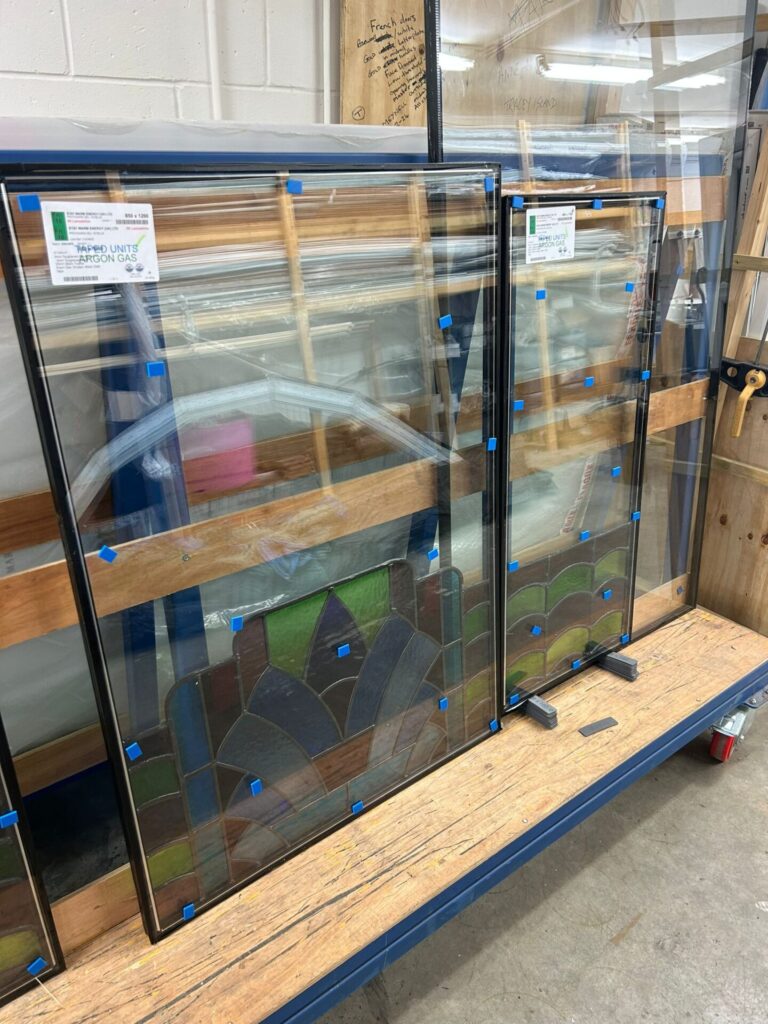Stained glass windows are more than just beautiful works of art; they are pieces of history that add character and charm to any home. However, many older stained glass windows lack the energy efficiency needed in today’s homes.
That’s where our stained glass encapsulation process comes in. By incorporating these intricate, historic designs into modern triple glazing, we can preserve their beauty while significantly improving the energy efficiency of your property. In this blog post, we’ll take you through the step-by-step process of how we encapsulated 100-year-old stained glass into a triple-glazed unit, demonstrating our commitment to quality and craftsmanship.
Breaking Down Previously Encapsulated Stained Glass
This particular piece of stained glass had been encapsulated in the past so we began by carefully breaking down the old unit. This allowed us to remove the stained glass and begin our preparations on the glass to ensure it was ready to be encapsulated in our signature glazing.

Resizing Unit
Next, we had to resize the stained glass unit to the appropriate size for encapsulation. This involved measuring the correct amount to remove from either side to ensure an even-sized unit.
We then marked out the cut and used a glass cutter to trim excess glass. Then we carefully bent the lead to ensure a clean break.
Designing & Creating Matching Side Panels
We were tasked with creating matching panels to be installed on either side of the main stained glass unit. We designed brand new panels and based our design on some old broken-down units from the property.
This involved meticulous frosting and colour matching to find the closest glass. We cut the glass and then framed it to form the side panel.
Lead Soldering
Once we had finished positioning and framing the glass, it was time to solder lead onto the corners and meeting points of the frame. This ensured it was sturdy and the glass would stay in the frame.
Sending Units To Be Encapsulated
Now the glass units were complete, we sent them off to our glass suppliers, CCG, who encapsulated them into triple glazing ready to be installed.
Encapsulating stained glass in triple glazing offers a host of benefits. Firstly, it significantly enhances the energy efficiency of your windows, helping to keep your home warmer in the winter and cooler in the summer.
This upgrade can lead to substantial savings on energy bills. Additionally, triple glazing provides excellent sound insulation, reducing external noise and creating a more peaceful living environment. The encapsulation process also protects the delicate stained glass, preserving its intricate designs and vibrant colours.

Installation Process
With the triple-glazed units ready, the installation process could begin. Precision and attention to detail were crucial to maintain the integrity and beauty of the stained glass.
Each unit was meticulously placed into its frame, ensuring a perfect fit and secure seal. The final step involved beading the glass and checking for any gaps to guarantee maximum insulation and energy efficiency. Throughout the process, we made sure to handle the glass with the utmost care.
The Final Product
The result of our stained glass encapsulation project is a stunning blend of old-world charm and modern efficiency. The vibrant, intricate designs of the 100-year-old glass are beautifully preserved and now shine brilliantly within the triple-glazed units.
This final installation not only enhances the home’s look but also boosts its energy efficiency. Check out the video of the process below!











